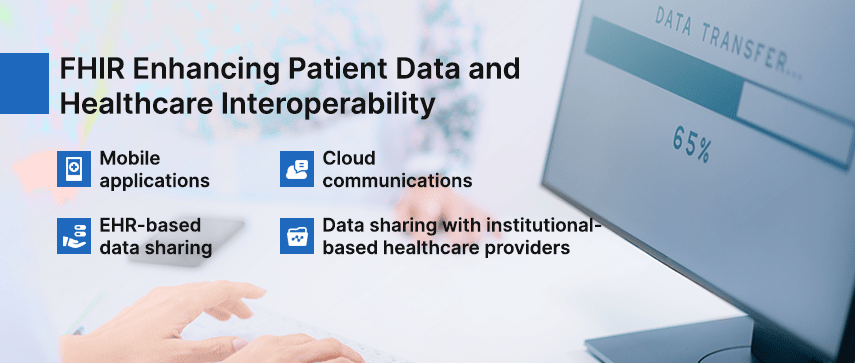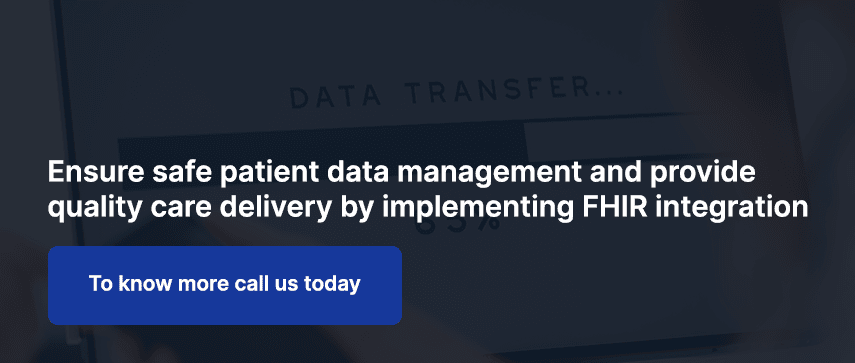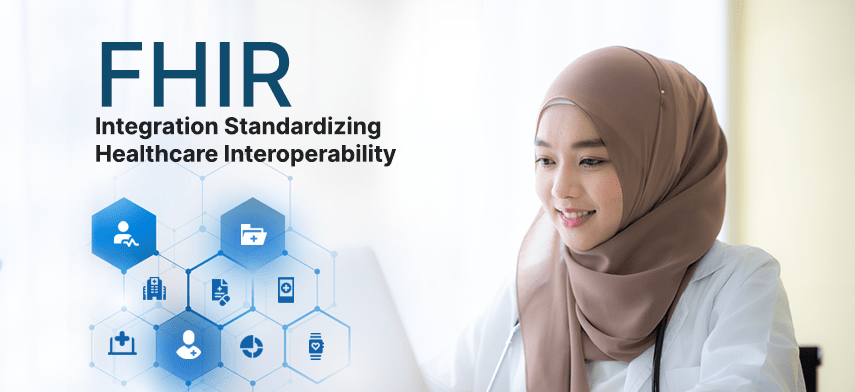It is succinct that improving the lives of humans can best be achieved through technological advances in medicine. Fast Healthcare Interoperability Resource or FHIR is quickly becoming one of the most frequent linking disparate systems. It has enormous promise for creating a framework approach to connection and health information exchange. FHIR promotes a strong development team to debate complicated problems, an open standard, future interoperability, a well-documented information model, and current internet applications that are simple to apply.
FHIR Standardization and its Role in Improving Healthcare Interoperability
Fast Healthcare Interoperability Resource has quickly become one of the most common points for connecting dissimilar systems. It offers tremendous potential for developing a framework approach to connectivity and health data interoperability. The International body created and maintained the Fast Consolidated Level Resource, a proposed data reference.
This system was designed with the complexity of healthcare data in mind, and it employs a contemporary, internet-based method to link several distinct pieces of health data. Their strategy aims to create a foundation pool of assets that fulfill frequent application cases either alone or in combination.
FHIR interoperability standards strive to specify the present scenario and architecture for most implementations' core data sets. FHIR assets can be used to create documents like a composition: a collection of cohesive data representing a declaration of health data, notably clinical findings and operations.
FHIR server integration assists in making wearable technology and tracking gadgets that are clinically approved and useful. Practitioners can adapt their toolkits to match the needs of their specialty or area of interest. For example, gathering data from various study services to make their diagnostic and treatment skills. Medical professionals can also send anonymized data to groups focused on growing a clinical research strategy for treating a rare malignancy. This will help facilitate correct data presentation and capture performance indicators.
Measure reporting entails the gathering and consolidating facts, the computation and analytics of quality measures, and finally, the reporting of quality measures. Individual providers attesting to:
- Particular quality metrics as part of federally regulated healthcare quality programs.
- Provider organizations reporting to healthcare plans as part of payer quality improvement efforts.
- Institutions reporting on the quality of their healthcare delivery.
They are all examples of how this can be performed at various levels of the healthcare delivery system.
The Progression of FHIR Integration
As FHIR has claimed its space and importance, it is noteworthy to understand its progression and offerings. Some of the key moment of FHIR integration services evolution includes:
1 Version 2 (V2)
Initially launched in the year 1980, the V2 is still widely known and commonly used. Its primary objective was clinical data delivery amongst admission, discharge, and transfer patients, EHRs, lab systems, etc. V2 incurred high success rates but it had its drawbacks. FHIR implementers were not satisfied with specifications, which were considered loose and often required custom tweaks when interoperating between two systems. This version’s messages were not semantic, proving it to be impossible to guarantee whether the receiver could decipher the clinical meaning of content.
2 Version 4 (V4)
The digitization of healthcare records is successfully reaching new heights. With the movement of patients across the healthcare ecosystem, it is a necessity to have their electronic health records available, understandable, and discoverable. HL7 has been tackling these challenges by reproducing information data modeling and healthcare data exchange for over 20 years. The new specifications of FHIR are based on the recent emergence of industry approaches. FHIR R4 is the first version having components reaching a normative. The specifications are considered stable and ready to be used. Every FHIR version requires to be backward compatible with R4 components improving interoperability standards.
Cruciality of FHIR for Enhancing Interoperability

As the healthcare industry waits for an industry-defined data model practical for business-critical analytics and results improvement, FHIR is gaining traction. Hence, prompting the healthcare information sharing industry to explore FHIR integration with medical systems.
The primary goal of FHIR creation is to construct a precise structure that can adjust to changing resources and be interpreted by any method. FHIR can thus be used in various applications that bring health data interoperability including:
- Mobile applications
- Cloud communications
- EHR-based data sharing
- Data sharing with institutional-based healthcare providers
FHIR is based on the principle of "tools," which are the fundamental units of interoperability maintaining necessary standards. They can be integrated into current processes to address clinical, logistical, and infrastructure issues in healthcare. The tools must all have the same description and representation system, a definitive collection of metadata, and a human-readable portion. The FHIR was created with web applications in mind, and it provides tools based on XML, JSON, HTTP, Atom, and OAuth.
FHIR offers software development tools and services for administrative concepts like patients, providers, organizations, devices, and health concepts like complications, treatments, diagnostics, treatment plans, and financial concerns.
The Distinguishing Factor of FHIR from Other Technologies in the Health Industry
HL7 created FHIR specifically for EHRs. The sole purpose of HL7 FHIR integration is to make EHRs and other healthcare applications that are FHIR-compatible easily interoperable. FHIR 4 (currently in its fourth iteration) is a draft standard that describes data formats and components, known as "tools." FHIR will aid in the exchange of knowledge and the implementation and support of mobile applications favoring providers, payers, and patients are also supported.
Clinicians can seamlessly share patient data among teams, allowing them to make faster decisions through the patient data management system. Insurance firms use clinical data to complement claims data to identify risks better, reduce costs, and improve results. Patients can now have more control over their wellbeing by using consumer-friendly applications on smartphones, laptops, and wearables to access medical information. The Centers for Medicare & Medicaid Services (CMS) in the United States finalized a mandate for the use of FHIR by several CMS-regulated payers and providers starting in mid-2021 in 2020.
Benefits Obtained by Using FHIR
FHIR integration with medical systems aims to standardize healthcare data sharing, allowing healthcare providers to easily share patient information even though they use different software systems. It removes the process of exchanging individual documents between different systems by creating standard URLs, resulting in quick, dependable access to accurate data.
Some of the main advantages of FHIR server integration are:
- Simple to execute.
- Allows for quick healthcare delivery while maintaining safe real-time access to high-quality data.
- Data is organized for automated clinical support.
- Allows for reliable, real-time access to high-quality data.
- Makes reporting quality metrics easier.

FHIR Integration for Vendors and Providers
Anyone with a stake in the world of healthcare data agrees that FHIR's digitized approach to exchanging and sharing information is commendable. The protocol offers the most tangible promise for achieving the industry's goals of health data interoperability, patient-centered and data-driven care.
Investing in FHIR-based Interoperability Frameworks enables CMS compliance to be achieved quickly and at a lower cost. Mobisoft's broad experience in healthcare solutions and its knowledge of the principles of healthcare compliance policy, data formats, and promoting the requisite technical standards, including implementation guides, have evolved to respond to any changes in regulatory requirements.
When it comes to supporting various healthcare customers, including payers, understanding HL7 FHIR implementation-based integration is profoundly engraved into our healthcare product creation process. Healthcare services platform consortium (HSPC) are using FHIR as their work’s centerpiece by creating an agnostic marketplace for applications requiring accessible data flow across disparate independent systems.
Every notable name in the electronic health record market uses FHIR for something that will transform their IT health landscape. Hackathons and developer programs are in popularizing FHIR programs. These hackathons bring developers together and get the brightest and best ideas on using health data management protocols. This is encouraging innovation, invention, and broadening developer communities.
To implement FHIR standards better, the organization needs to understand customer adoption needs and priorities. Implementing federal requirements requires complex use cases, which in turn require more data sources. Some adoption models that organizations can endorse to implement fast healthcare interoperability resources are complex and high-value use cases. To achieve and sustain data-driven improvements in healthcare, vendor technical readiness is essential. Consumer engagement through FHIR will occur with the use of relevant data.
Bottom Line,
Technical developments in medicine are the most effective way to improve people's lives. FHIR has immense promise to develop a framework approach to connectivity and health information sharing as it incorporates the collective expertise of many specialists. FHIR is an excellent data format for storing clinical and financial data. Individual providers attesting to specific quality measures as part of federally controlled healthcare quality programs enhancing patient data management systems. Therefore, provider organizations reporting to healthcare plans as part of payer quality improvement initiatives, and institutions reporting the quality of healthcare delivery are all examples of how this can be done at different levels of the healthcare delivery system.





 June 25, 2021
June 25, 2021


